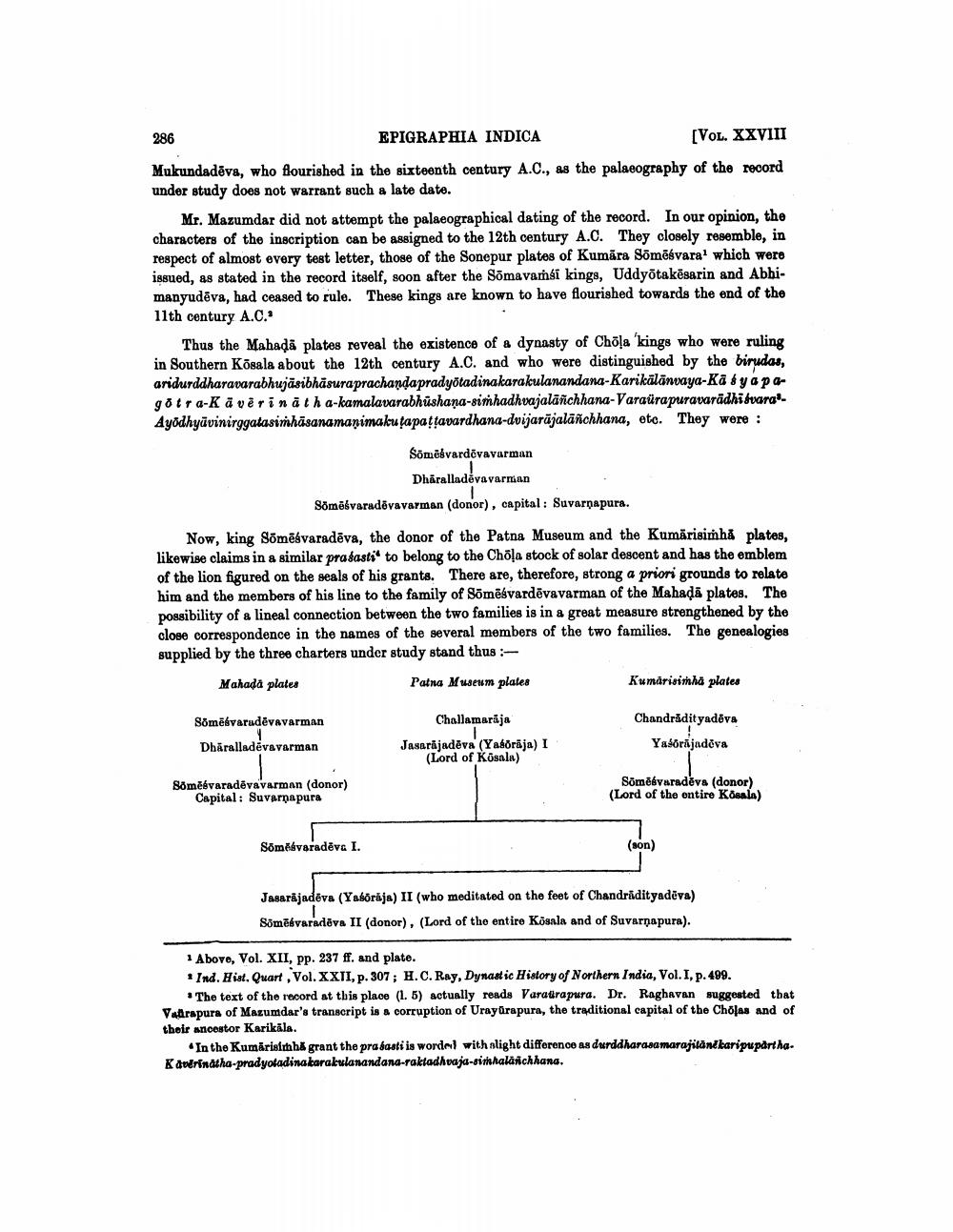________________
286
EPIGRAPHIA INDICA
[VOL. XXVIII
Mukundadēva, who flourished in the sixteenth century A.C., as the palaeography of the record under study does not warrant such a late date.
Mr. Mazumdar did not attempt the palaeographical dating of the record. In our opinion, the characters of the inscription can be assigned to the 12th century A.C. They closely resemble, in respect of almost every test letter, those of the Sonepur plates of Kumāra Somēsvara' which were issued, as stated in the record itself, soon after the Sõmavamsi kings, Uddyötakësarin and Abhimanyudēva, had ceased to rule. These kings are known to have flourished towards the end of the 11th century A.C."
Thus the Mahadā plates reveal the existence of a dynasty of Chõļa 'kings who were ruling in Southern Kõsala about the 12th century A.C. and who were distinguished by the birudas, aridurddharavarabhujāsibhăsura prachanda pradyötadinakarakulanandana-Karikälānvaya-Kasyapagotra-Kā vērināth a-kamalavarabhushana-simhadhvajalāñchhana-Varaurapuravarādhi svara! Ayodhyāvinirggatasimhāsanamanimakutapattavardhana-dvijarājalāñchhana, etc. They were :
Sömisvardēvavarman
Dharalladěvavarnan
Sömēšvaradovavarman (donor), capital : Suvarnapura. Now, king Sõmēsvaradēva, the donor of the Patna Museum and the Kumārisimhả plates, likewise claims in a similar prasasti to belong to the Chõļa stock of solar descent and has the emblem of the lion figured on the seals of his grants. There are, therefore, strong a priori grounds to relate him and the members of his line to the family of Sõmēšvardēvavarman of the Mahadā plates. The possibility of a lineal connection between the two families is in a great measure strengthened by the close correspondence in the names of the several members of the two families. The genealogies supplied by the three charters under study stand thus :Mahadà plates Patna Museum plates
Kumarisimha plates
Somēbvarudēvavarman
Challamarāja Jasarajadēva (Yaáðrāja) I
(Lord of Kosala)
Chandrådityadēva
Yasorajadova
Dbäralladévavarman
Sõmēsvaradevavarman (donor)
Capital: Suvarnapura
Sõmēsvaradeva (donor) (Lord of the entire Kosala)
Somēévaradēva I.
(son)
Jasarajadēva (Yabörja) II (who meditated on the feet of Chandradityadiva) Sömēbvaradova II (donor). (Lord of the entire Kösala and of Suvarnapura).
1 Abovo, Vol. XII, pp. 237 ff. and plate. * Ind. Hist. Quart , Vol. XXII, p. 307; H.C. Ray, Dynastic History of Northern India, Vol. I, p. 499.
• The text of the record at this place (1.5) actually reads Varadrapura. Dr. Raghavan suggested that Vedrapura of Mazumdar's transcript is a corruption of Urayurapura, the traditional capital of the Cholas and of their ancestor Karikala.
In the Kumarisithi grant the prasasti is wordel with slight difference as durddharasa marajitandkaripupartha. Kadrinatha-pradyotadinakarakulanandana-raktadhuaja-sithalaichhana.




